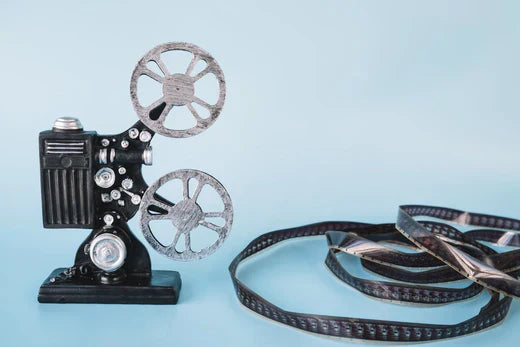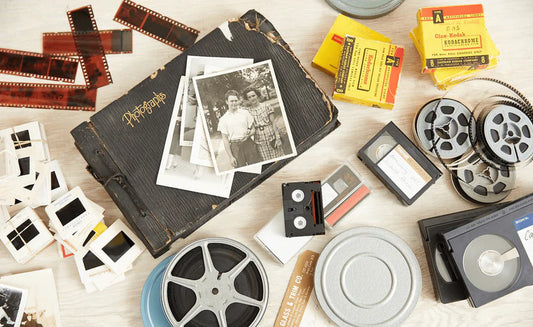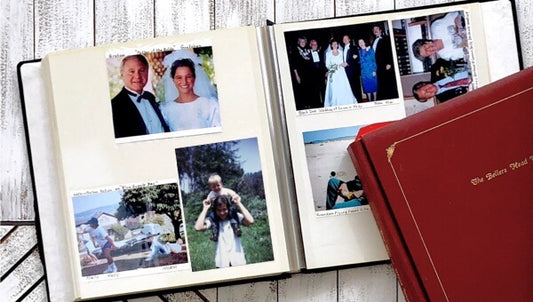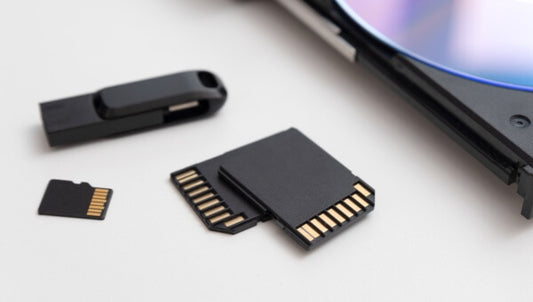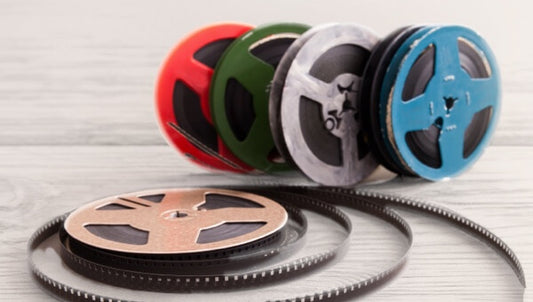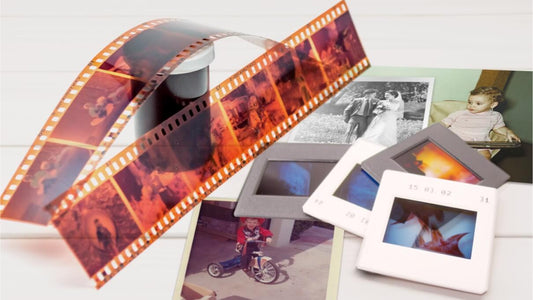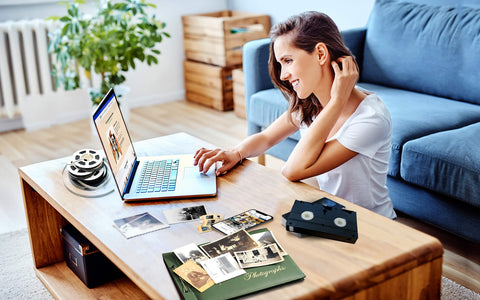If you have some old 16mm film reels lying around, they might contain precious memories of people you haven’t seen or heard in years. Without a projector, it might be difficult to know what to do with them so you can enjoy your home movies. The good news is that there are several ways to view film movie formats without a projector. Capture archival experts have preserved memories for over 20 years, so we put together this guide on how to view 16mm film without a projector so you can finally enjoy your home movies without spending a fortune on an antique Bell & Howell or Kodak projector.
Keep reading to learn all the best ways to view your film reels without a projector including using an editing viewer, DIY lightbox, film scanner, magnifying glass, digital camera, film projection services, or professional film transfer service.
Jump to:
- Film Editing Viewer
- DIY Lightbox
- Film Scanner
- Professional Film Transfer Services
- Magnifying Glass or Loupe
- Digital Camera or Smartphone
- Professional Film Projection Services
- Conclusion
Film Editing Viewer
Vintage film editors or viewers are designed to make splicing, cleaning, and fixing analog film easier for filmmakers and editors. However, it can also be used to view your 16mm film without a projector. There are different designs to be aware of including hand cranking types that include a built-in screen or others that work similarly to a compact film projector.
To use a film editor, you’ll simply need to place the reels on the machine, turn it on or use the hand crank to “play” the home movies, and then view it on the viewing screen or as a mini projection on a table. However, you need to be careful not to damage your film, particularly with hand crank options.
While most of these are antiques that cost as much as an old projector, there are cheaper options available online for $20 to $30. The best versions can cost $100 or more, which means you might as well buy a cheap projector instead. Still, it’s an alternative that’s really cool especially if you also want to splice, cut, edit, or clean your 16mm film.

Pros
- Can be used for film repairs
- Works with 8mm and Super 8mm film reels as well as 16mm
- Double as an antique decorative piece
Cons
- Only available used and may not be in great condition
- Many are heavy and inconvenient
- Best film editing viewers in good condition cost $100+
DIY Lightbox
Lightboxes make it extremely easy to view your old film because they use a backlit light source to illuminate your film. Then, you can manually view your memories frame by frame. They are generally affordable and are one of the easiest ways to view your 16 mm film without a projector. All you need for this option is the lightbox and film and you can instantly start enjoying.
However, there are some limitations. First, not all lightboxes are designed specifically for film and may be too bright or too dim. Second, it doesn’t allow you to share the memories with others and you will only be able to view frame by frame instead of as a motion picture.
For the best results, you may have to combine this option with a magnifying glass or digital film camera. That way, you aren’t watching tiny film images. With a digital camera, you can also share the images with loved ones much easier.

Pros
- Affordable
- Easy to use
Cons
- Must view frame-by-frame
- Can be hard on eyes without a magnifying glass
- Many options aren’t designed specifically for film, so may be too bright or dim
Film Scanner
Film scanners are DIY devices that transfer your old film reels into digital format, but most are designed for 8mm and Super 8mm film projector reels and won’t work for 16mm film, including the popular Wolverine Film Converter and popular Kodak REELS. However, some options can work with your 16mm including the ELMO 16mm Optical Projector Tele Cine Video Transfer on eBay.
The main downside is that these machines are expensive compared to the more popular 8mm options. They work by turning your film movies into digital videos, so you will have digital files that you can save, share, and enjoy for years to come. Plus, it ensures those memories are never lost because the full video will be saved to your hard drive, cloud storage, or computer.
Another option is to use a standard flatbed scanner. While this will only save images of your memories, you can use certain software programs to create a slideshow or seamlessly edit them together to create a seamless video. That’s more work but can be more affordable as well.

Pros
- Good quality results
- Creates digital video that preserves your memories
- Can also use a high-quality photo flatbed scanner
Cons
- Time-consuming because film scanners only digitize frame-by-frame at normal playback speed
- Expensive (for dedicated 16mm film scanners)
- Hard to find machines that accommodate 16mm reel and sprocket sizes
Professional Film Transfer Services

Another option to preserve your memories and create digital files that you can edit, enjoy, and share with loved ones and subscribers is to use a professional film transfer service. These services will turn your analog film reels into digital videos saved onto the cloud or a hard drive. There are many different film transfer services to consider, each with different pricing, results, services, and more.
When choosing a film transfer service to digitize 16mm film, it’s important to make sure they have a good track record of successful transfers and satisfied customers. Additionally, you’ll want to make sure that you don’t overpay, your memories will be cared for, and the turnaround time is short. You can find this information on a company’s website, but you should also read reviews to get other customers’ points of view.
Capture offers over 20 years of experience transferring memories into high-quality digital copies for an affordable price. Our satisfaction guarantee and multi-million-dollar tracking and security system ensure your memories are safe, secure, and digitized to the best quality. Plus, our 30 day turnaround time is among the best in the industry.

Pros
- Professional digital videos
- Security and care for your original memories
- Won’t need to spend money on a projector, light box, scanner, or any other device
- Many will also transfer camcorder videotapes like VHS as well as photos and more
Cons
- Some services are more expensive than others
- Most options won’t enhance or edit your film in any way (Capture will clean and splice if necessary for transfer though!)
Magnifying Glass or Loupe

A high-powered magnifier can allow you to view your 16mm film reels as well as 8 mm film without straining your eyes too much. Some magnifying glasses also come with a light on the end so you can actually see your 16 mm film without a movie projector. While this is one of the easiest ways for how to view 16mm film without projector, there are some downsides as well.
This option is limited to one viewer at a time and one frame at a time. That means that you will still need to transfer the film to digital format, buy a projector, or use another option to share your precious memories with friends and family. Plus, it is slow, hard on the eyes, and offers the least quality of any option on this list.
Regardless, this is a convenient way to identify what is on each film reel so that you can decide what to do with them. If the film contains memories you want to cherish forever, then you can proceed with a professional film transfer or DIY digitization.

Pros
- Very affordable at as little as $5 to $10 for a 10x magnifying glass
- Easy to use because you simply use the magnifying glass in a well-lit room
- Instant viewing capabilities
Cons
- Time-consuming to view more than a few frames
- Cannot share the memories with others
- No high-quality results
Digital Camera or Smartphone

You can also use a digital camera or smartphone to digitize, magnify, edit, and share your 16mm film memories. You’ll need to set the film up in a well-lit area and then take steady pictures of each separate frame. If this is your preferred option, we recommend combining it with a light box for clearer images.
The results will depend on the quality of your camera, but if you have a high-quality digital camera made by Sony, Canon, or another reputable brand then there are some good benefits to this method. It’s close to free if you already have a smartphone or digital came. Plus, it creates digital files that you can then edit, share, view, and more.
Unfortunately, it’s not great when it comes to quality and the results will be pictures of analog film instead of direct scanning. The result is a lower resolution that also shows glares, scratches, and other imperfections.

Pros
- Convenient if you already have a digital camera
- Easy to do on your own
- Creates digital files to preserve film
Cons
- Low-quality results
- May take practice to get steady, centered, focused images
- Still need a light source for film
- May show glares, scratches, dust, and more
Professional Film Projection Services

There are a couple of different types of film projection services that can help you view your film. The first is simply a projector room with a screen that you can rent or use. This is a great option for family reunions and events and also offered professional equipment, often including sound equipment, visual lighting, and more.
The other option is to rent a projector from a service. This means you get the benefits of being able to view your home movies on a projector without having to spend so much on one. Both of these options are great ways to view your film as originally intended but will not preserve your movies and can end up being expensive if you want to use them often.
Plus, these services aren’t common outside of large cities, which can be limited depending on your location. Still, it will allow you to view your memories using professional grade equipment and some options will even include an operator who can take good care of your film reels during projection.

Pros
- Professional quality projectors
- Often more affordable than buying an antique projector
- Great for viewing memories with loved ones, friends, and family
Cons
- Will get expensive if you want to use often
- May be hard to find in some areas
- Does not preserve your memories

View and Watch 16mm Film from Home Without a Projector and Keep Your Memories Alive
Your 16mm film reels can contain priceless moments, graduations, friendships, loved ones, weddings, and more. Knowing how to view 16mm film without projectors is a great way to finally enjoy those memories and share them with others. There are many options including using a film viewer or lightbox to view your film or using a film scanner or digital camera to digitize it.
Capture can turn your 16mm, 8mm, and Super 8 memories into high-quality digital videos to preserve them for future generations. This creates digital heirlooms and makes it easy to view and share your memories online.



